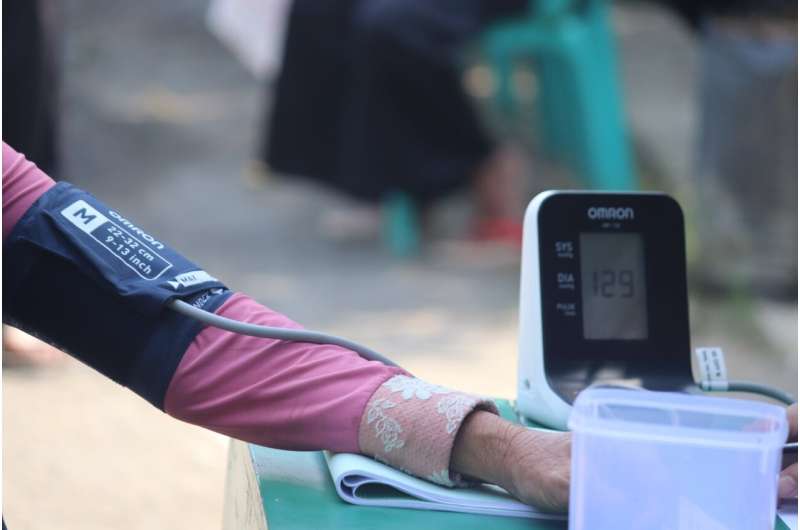This article has been reviewed according to Science X's editorial process and policies. Editors have highlighted the following attributes while ensuring the content's credibility:
fact-checked
peer-reviewed publication
trusted source
proofread
Optimal blood pressure levels for reducing CVD mortality risk identified in large Asian diabetes cohort

Keeping blood pressure in check could save lives among Asian adults with type 2 diabetes, suggests a sizable new study of more than 80,000 patients in Singapore. But how low should it go?
A new study led by Duke-NUS Medical School, published in the Journal of the American Heart Association, examined how different blood pressure levels related to risk of dying from heart disease in Asian adults with type 2 diabetes.
It found that the lowest risk was at a systolic (top number) blood pressure of 120–129 mmHg. Risk sharply increased once systolic levels reached 130 mmHg or higher. For diastolic (bottom number) pressure, the lowest risk was around 80–89 mmHg. Levels above 90 mmHg increased risk in older adults.
However, the study also found that diastolic pressure below 70 mmHg paradoxically increased cardiovascular risk.
"Diastolic pressure under 70 mmHg could potentially be harmful in patients with diabetes, although it's unclear if that association was directly causal," explained the study's senior author Professor Tazeen Jafar from the Health Services & Systems Research (HSSR) Program at Duke-NUS, who presented the study's findings at the annual meeting of the American Heart Association in Philadelphia, U.S. "Our analysis underscores the need to control elevated systolic blood pressure to less than 130 mm Hg in patients with diabetes, while carefully evaluating risks if diastolic pressure gets too low."
The findings support clinical guidelines recommending systolic targets below 130 mmHg in patients with diabetes to protect against heart disease and stroke. But they suggest being more cautious about lowering diastolic pressure too far below 70 mmHg.
The researchers said the results are particularly relevant as populations in Asia face high and rising rates of diabetes, carrying greater vascular risk than Western populations.
Studies on the relationship between blood pressure and cardiovascular risk in Asian diabetic patients have reported conflicting results, with some finding intensive lowering to <120–130 mmHg reduces risk further versus standard <140 mmHg targets, especially in younger patients, while others find no additional risk reduction below 140 mmHg. These differing findings may relate to study differences in age distributions, blood pressure assessment methods, follow-up periods and confounder adjustments, leaving optimal blood pressure targets uncertain for Asian diabetic populations.
"With the worrying global deterioration in blood pressure control, including in the U.S. and here in Singapore, this study is an urgent reminder of the critical need for more effective blood pressure management in those with diabetes," remarked Prof Jafar, who is also Professor of Global Health at Duke Global Health Institute, Duke University, in the U.S. "Doctors and patients should work together to lower elevated systolic pressure through lifestyle adjustments and medications, while monitoring diastolic levels and overall health."
Stressing the need for multi-sectoral efforts to enable better blood pressure control, Prof Jafar added, "Achieving optimal targets requires collaboration between government, health care systems, community organizations and other partners to improve access to medicines and promote healthier lifestyles.
Prof Jafar and her co-authors analyzed patients enrolled in the SingHealth Diabetes Registry, a large multi-center database. Researchers examined the relationship between different systolic and diastolic blood pressure levels and risk of cardiovascular mortality over seven years of follow-up.
They performed detailed analyses, accounting for patient factors like age, gender and existing heart disease. Several sensitivity analyses confirmed the robustness of the results.
"Research initiatives to translate evidence-based guidelines into real-world practice are vital. Our group aims to scale up strategies to enhance blood pressure control and cardiovascular risk reduction in Asian populations burdened by diabetes," said study co-author Clinical Associate Professor Bee Yong Mong from the SingHealth Duke NUS Medicine Academic Clinical Program, who is Head and Senior Consultant with Department of Endocrinology at Singapore General Hospital (SGH).
Professor Patrick Tan, Senior Vice-Dean for Research at Duke-NUS, commented on the public health implications of the findings. "With rising rates of diabetes and hypertension in many parts of Asia, this study provides crucial insights on evidence-based blood pressure targets that reduce risk of cardiovascular mortality. We hope these help bolster efforts to implement optimal management of hypertension," said Tan.
The research was conducted as a collaboration between investigators from institutions that are part of the SingHealth Duke-NUS Academic Medical Center, namely Duke-NUS, SGH and Changi General Hospital.
More information: Seng LL et al, Real-World Systolic and Diastolic Blood Pressure Levels and Cardiovascular Mortality in Patients with Type 2 Diabetes—Results from a Large Registry Cohort in Asia, Journal of the American Heart Association (2023). DOI: 10.1161/JAHA.123.0123456. www.ahajournals.org/doi/10.1161/JAHA.123.030772



















